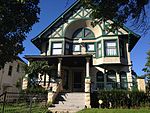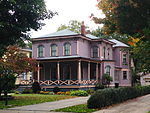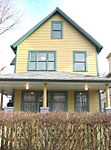St. Barbara Church (Cleveland, Ohio)
1905 establishments in Ohio20th-century Roman Catholic church buildings in the United StatesChristian organizations established in 1905Churches in the Roman Catholic Diocese of ClevelandIncomplete lists from July 2019 ... and 3 more
Polish-American culture in ClevelandRoman Catholic churches completed in 1951Roman Catholic churches in Cleveland
St. Barbara Catholic Church (Polish: Parafia św. Barbary w Cleveland) is a parish of the Roman Catholic Church in Cleveland, Ohio, within the Diocese of Cleveland. The parish church is located on Denison Ave. between West 16th St. and the southbound entrance to SR 176, in a part of the Brooklyn Centre neighborhood previously known in Polish as na Barbarowie.The red brick parish church, designed by H.C. Gabele, is a local landmark. It is a GNIS named feature. The church, rectory and convent buildings are listed together as a Cleveland Designated Landmark.The parish was established in 1905.
Excerpt from the Wikipedia article St. Barbara Church (Cleveland, Ohio) (License: CC BY-SA 3.0, Authors).St. Barbara Church (Cleveland, Ohio)
Denison Avenue, Cleveland
Geographical coordinates (GPS) Address Nearby Places Show on map
Geographical coordinates (GPS)
| Latitude | Longitude |
|---|---|
| N 41.45148 ° | E -81.69134 ° |
Address
Denison Avenue 1427
44109 Cleveland
Ohio, United States
Open on Google Maps









